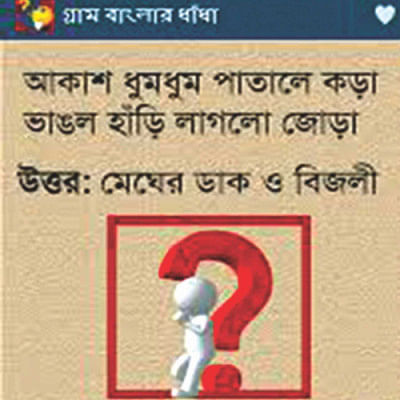Riddle me this

Nasrin Sultana, 56 and mother of two, remembers a radio show she and her sisters most enthusiastically used to listen to in their childhood. The programme, she says, was probably aired sometime in the late 1960s. The show involved the radio host asking riddles to his guests in the studio (a group of young children). The children were allowed around 10 questions, to grasp what the answer could possibly be, and then finally the solution or answer was revealed. "We used to huddle around the radio trying to solve those riddles ourselves," she says.
Even after so many years, Sultana remembers the show quite well. Such was the excitement about it in her home. Riddles are indeed fascinating. They capture a child's imagination and amusement, and they make both children and adults scratch their heads. Moreover, they can even be deemed as a beautiful medium of creative expression, an age-old spoken literary tradition.
Sultana thinks that the tradition of riddles is gradually waning. Another riddle enthusiast, Nusrat Mallick, 38, who lives in Comilla, looks back to her childhood. "My mother used to know a lot of riddles. It was her hobby to collect them. She maintained a small, black diary, and whenever she heard or read a new one, she used to jot it down," Mallick walks down the memory lane. "And she always used to challenge her friends, acquaintances and her children with different riddles. During Eid holidays, when the house was full of kids, all of us used to surround her whilst she asked amusing riddles."
Mallick regrets that the diary, which could now have been a living memory of her mother, had been lost many years ago. Nevertheless, from the fond memories and from different books, she tells riddles to her small children. "It is a creative and interactive exercise for them," she believes.
Can riddle solving be a creative exercise? Why not? Riddles are a sort of problem, which requires analytical, creative, and logical thinking to solve them, where you start with clues, sometimes ask for further hints, and perhaps even paint a picture in your mind. Try solving this:
"Jhikjhik jhikjhik
Akey bekey choli,
Pothe pothe manush khai
Abar ugrey feli."
Didn't your mind wonder when you read the riddle above? What was your deduction process? What were the questions you asked yourself? What have been your top guesses?
I reckon this riddle is surely an extremely simple one. Most of you have solved this quite easily. For those who are still scratching their head, keep scratching! I am not going to give away the answer in this article!
Riddles tease people's minds a lot. "When your friends have solved one but you cannot, it teases you further. It becomes addictive," Mallick says.
Introduce your children to riddles; Bengali riddles in particular. They will not just be fun and enhance your child's creative process, they will also open a window to Bengali culture, folklore, and language.
The composition of riddles is more or less similar to that of rhymes or 'chora', which not only attracts children, but opens up a world of literature and language.
Riddles can also be a fun way of introducing different traditional objects prevalent in rural Bangladesh. Here's another riddle for you:
"Shur diye kaj kori
Nohi ami hati,
Porer upokar kori
Tobu khai lathi"
Did you solve it? Here's a hint: it's a traditional item found in many households in Bangladeshi villages. So, riddles can be an attractive way of introducing your children to Bengali culture and heritage. From being a fun pastime to an interesting exercise which could enhance your child's reasoning and knowledge, riddles provide a lot.
Therefore, make it a point at home to challenge your children with riddles. If not anything else, they will one day bring fond memories.
Still thinking what the traditional item the riddle above was talking about? It's 'dheki'!
By M H Haider
Photo: Collected

 For all latest news, follow The Daily Star's Google News channel.
For all latest news, follow The Daily Star's Google News channel. 


Comments